Conservation is an integral part of our mission at Zoo Atlanta.
Accredited zoos play an important role in the conservation of wildlife and wild places around the globe. As collaborators, zoos work with government agencies, non-profits, conservation organizations, universities, and others to help address regional and global threats to biodiversity and find solutions to mitigate population declines.
Through innovative approaches and expertise in the field, zoos play a crucial role in saving species.
In the last 50 years, North America has lost nearly 3 billion birds. This staggering number accounts for more than one in four birds that have been lost to environmental and human impacts. Climate change has played a role in species declines as well as light pollution, city skyscrapers along migration routes, loss of natural resources, and threats like outdoor cats.
Birds are a valuable part of the ecosystem and play a key role as indicators of biodiversity. Bird populations are highly sensitive to environmental changes, so they are often among the first to show signs when something is wrong. As an integral part of the food chain, birds keep insect and rodent populations in check. Many bird species are also seed dispersers, allowing plants to distribute across wide ranges.
At Zoo Atlanta, we are interested in the decline of bird populations and understanding how we can intervene most effectively to save species. In partnership with Birds Canada, Zoo Atlanta recently installed a Motus tower as part of the Motus Wildlife Tracking System. Through this technology, we are now connected to an international collaborative research network that can use radio telemetry data to facilitate research and education on the ecology and conservation of migratory bird species.
Conservation action must be collaborative and based in science. It requires asking questions and investigating the answers to help formulate solutions. Effective conservation action follows the same iterative process as scientific inquiry; programs adapt and change as more is learned about the outcomes of conservation work.
Follow the conservation process on this year’s Education Poster to better understand how Zoo Atlanta and our partners use broad-based technology to understand bird populations and make threat assessments that will help drive solutions.
There are many ways to get involved in conservation to make a positive difference for wildlife and their habitats! We hope this poster will enhance your curriculum and inspire your students to take conservation action. To learn more about conservation projects at Zoo Atlanta and to learn how you and your students can get involved, visit our Conservation page.
Use the poster to connect to your curriculum! View our past poster designs and curriculums to further your learning in the classroom.
- Next Generation Science Standard (NGSS): 3-LS1-1
- Georgia Standard of Excellence (GSE): SKL1a, S1L1, S2L1, S3L1, S4L1, S7L1
There has been a significant decline in bird populations over the last 50 years due to environmental and human impacts. It is difficult to get an accurate count of bird populations due to the vast distances that migratory birds travel.
Use this year’s Education Conservation Poster to connect students to conservation science and find out how STEM technology is helping scientists better study migratory species. Data collection adds pieces to the puzzle as conservationists seek answers.
Start by showing students this screenshot of data from motus.org.
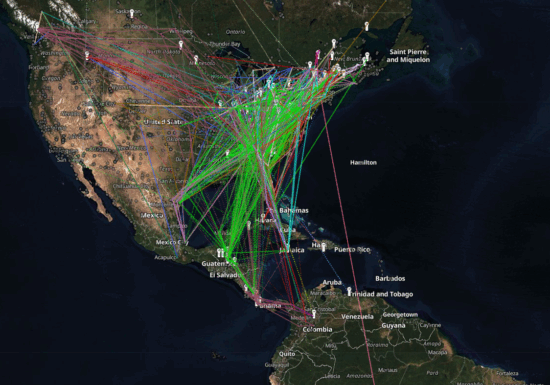
Students should ask questions about anything that sparks curiosity. Students begin by describing their observations and recording questions in STEM journals. Some students may be familiar with bird species, while others may recognize the outline of the continental United States map. Accept all observations and questions as a starting point for conversation or student-led research. You can prompt students’ thinking by asking them to jot down the answers to the questions “What do you notice?” and “What do you wonder?”
Once students have had an opportunity to record observations and questions about data, explain that the map shows the recorded routes of multiple species of birds that have passed through Motus stations found in the Southeastern United States.
A Motus station is an automated radio telemetry station designed to listen to specific types of radio transmitters used to track wildlife.
A Motus station has three main parts:
- Receiver: This is the computer that records and stores the radio data.
- Antennas: There are several types of antenna designs. They are 'tuned' to listen to a narrow range of frequencies. Each antenna gets its own coaxial cable and, depending on the receiver type and listening frequency, its own 'dongle', or USB devices that listen to a specified frequency range (i.e., software-defined radio).
- Power supply: This provides power to the receiver. Most off-grid stations use solar power, but AC power is most reliable. The number one reason for a station to malfunction is a power failure.
How does Motus work?
Researchers attach lightweight nano tags to birds, bats, and large insects like butterflies or dragonflies. A network of over 1,500 receivers, strategically placed, detect signals from the tags. When a tagged animal passes within range, the animal’s unique signal is stored. The data is collected and uploaded to a central database that is accessible to researchers and the public.
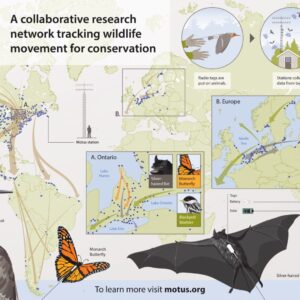
Graphic source: https://motus.org/resources/infographics-and-signage/
Student research: Using an approved website, students should be asked to research the life cycles of a bird, bat, or large insect listed under the species tab on motus.org. Students should research the size, region, diet, and population of species. A sketch of the species should be included in STEM notebook or journal. Students should be encouraged to take the role of a researcher by asking questions about the species being researched.
Take a trip to the Zoo: Book a Wild Walk program today! Students can learn more about how now animals are adapted to survive in their habitats and the unique roles that animals play within their ecosystems
- NGSS: 2-LS4-1, 3-LS3-1, 3-LS4-3
- GSE: S3L1b, S7L4, SZ5a
Class brainstorm: Migration is difficult and dangerous. What are some obstacles and challenges birds face when they migrate?
Migration is the regular movement that certain animals make between regions throughout the year. Birds migrate for different reasons. Not all birds migrate, but some travel thousands of miles between summer breeding grounds and wintering grounds. Birds need a steady food supply, and many bird species avoid harsh climates.
To protect migratory birds, scientists need to understand where birds go and how they interact with their environments during each season. Looking at the yearly cycle, we can see where birds are going and how long they are staying. Motus tracking provides important data for conservation scientists.
Here’s how it works:
- Tracking Migratory Routes: Motus provides detailed information about the routes and stopover sites that migratory birds use during their journeys.
- Understanding Habitat Use: Researchers are able to map where birds spend their time throughout the year.
- Researching Bird Behavior: Motus data can answer questions about the timing and duration of migration, the impact of human activities on birds, and other aspects of bird behavior.
- Informing conservation efforts: Motus data can be used to guide conservation actions, determine habitat management practices, and prioritize areas of importance.
Motus is helping birds by gathering essential data that give conservation planners the information they need to advocate for land and other environmental protections that will help birds to survive and thrive!
This map shows the geographic ranges of magnolia warblers during their annual cycle. Students can view an animated map that shows distribution through the year here.
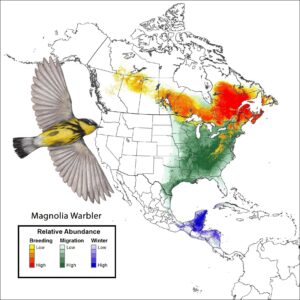
Graphic source: https://www.stateofthebirds.org/2016/resources/species-abundance-maps/magnolia-warbler/
Create a connection between your students and wildlife and wild places while supporting your classroom curriculum and the Georgia Standards of Excellence in Science by bringing your class to Zoo Atlanta for a Zoo Challenge.
- NGSS: K-ESS3-3
- GSE: S1L1, S3L2, S4L1b
The original tracking method utilized in the United States since the early 1800s is a “Mark and Recapture” process called bird banding. Birds are caught; details like age, sex, length, and weight are recorded; a band with a unique number is attached to one leg; and the bird is released back into the wild. If the bird is caught again, details are recorded at the next location. This video explains how bird banding works. For more information about the history and practice of bird banding as a method for gathering data that are utilized for research and management of birds, click here.
Because bird banding requires the recapture of birds to gather continuous data, it is somewhat unreliable due to a relatively low recapture rate. In contrast, the Motus network can identify tags that utilize radio transmitters to track tagged animals as they fly in proximity to a Motus tower.
Biologists attach small temporary radio transmitter backpacks on migratory birds and install Motus towers along migratory bird paths around the world to collect data on individuals and species as they travel past the different towers. Data are shared across organizations to understand population trends regionally and globally.
Through collaboration with partners around the world, avian scientists utilize the technology of the Motus Wildlife Tracking Systems to gather and share data that captures population assessments across geographic ranges and globally. They can then interpret the data to identify locations where birds are found, and in turn work to identify threats impacting these habitats.
Click the link below to see thrush migrations in Spring 2016:
This graphic shows the complexity of pinpointing causes for bird populations in decline.

Graphic source: https://www.trgt.org/woth-motus-project
Design a food web model to show the connections between thrushes and their ecosystem.
Students can observe Zoo animals firsthand and learn more about Zoo Atlanta’s many conservation initiatives on a Self-Guided Field Trip. Plan a field trip to Zoo Atlanta
- NGSS: 2-LS4-1, MS-LS2-2, HS-LS2-8
- GSE: S7L4, SEC3
As more birds are tagged with radio transmitters and additional towers are installed, it will become easier for organizations to look for trends in data regionally, globally, and by species to better understand where declines are taking place and what threats bird species may be facing. Additional data are referenced including weather and climate patterns, natural resources, and other environmental and human impacts on the ecosystem. Compare the migration of the black-capped chickadee with the American robin. The purple shows the year-round range in North America. Which species can find food in the same place all year round? The American robin moves to find food in different seasons.
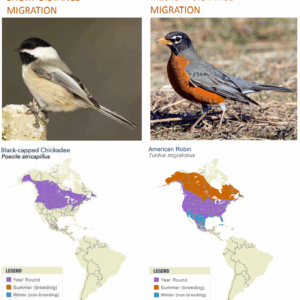
Graphic source: https://motus.org/wp-content/uploads/2025/03/MigrationPresentation22Nov2019.pdf
Look at the American robin's annual migration cycle. Consider a human-related threat and a stewardship action that might impact its survival during winter, migration, and summer.
Example: During migration, spring and fall, the American robin travels great distances through unfamiliar places. They will be tired and thirsty. Clean water in a birdbath, turning off outdoor lighting at night, and locking up cats can protect American robins passing through.
Here are the four major routes traveled during spring and fall migration. These are called flyways. Which flyway are we in?
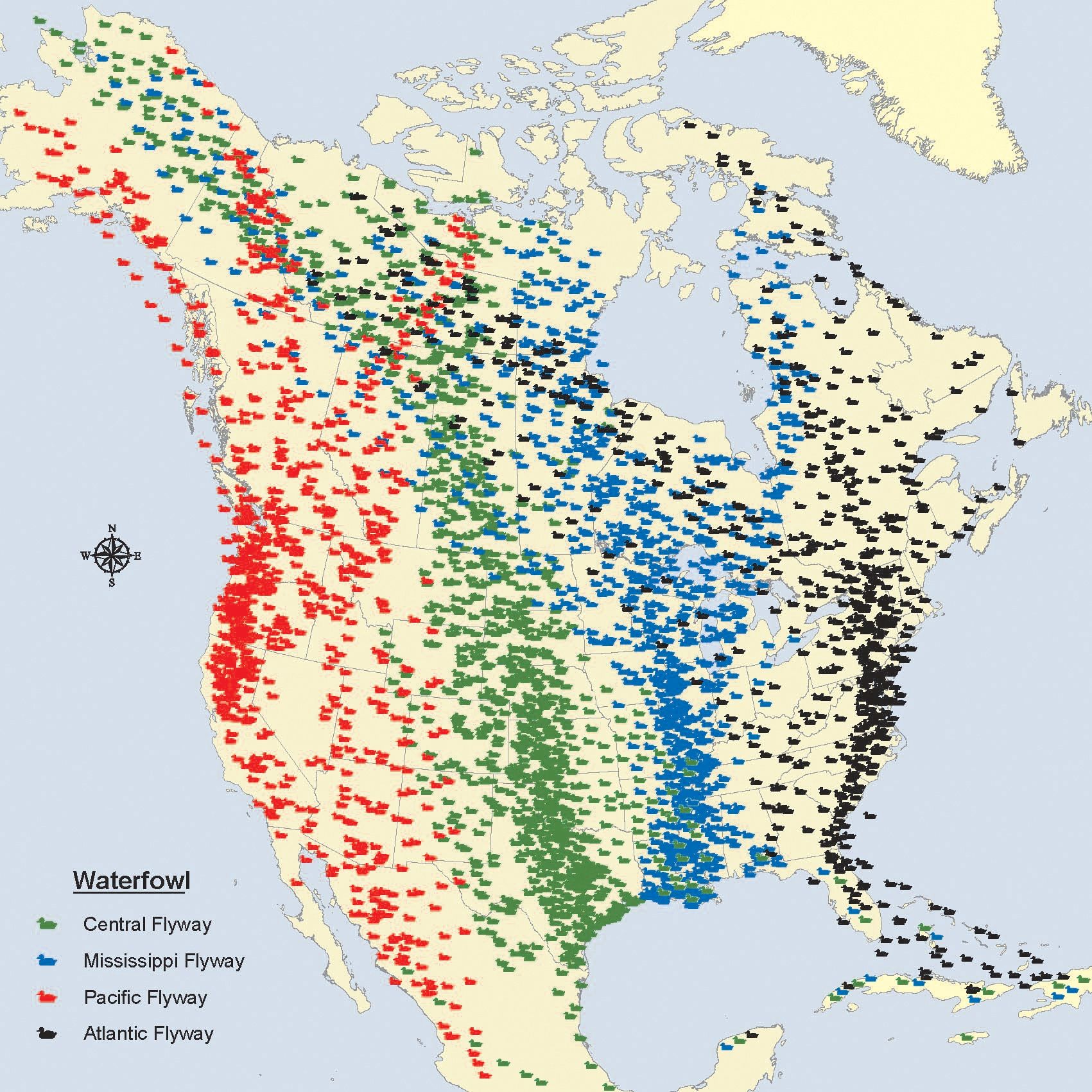
Graphic source: https://www.fws.gov/media/migratory-bird-flyways-north-america
Would you like to learn more about wildlife by observing some ambassador animals in your classroom this school year? Our ZooMobiles can bring the Zoo to you! For more information and to reserve your program, click here.
- NGSS: K-ESS3-3, HS-LS2-7,
- GSE: S2E3, S5L4, S4L1c
Once data have been analyzed to identify hazards, people must come up with possible solutions.
What can humans do to help migrating birds?
- There are many ways we can help to conserve birds. Learn how we can be ‘bird-friendly’ at school, home, and in our communities; and share with others. Here are some ways you can support native wildlife.
- Students may develop a plan to make a rest stop for migrating birds to eat, drink, and rest safely on their journey. Challenge students to design a school garden improvement that is helpful to birds. You can learn more about native plants that help birds thrive in Birds Georgia’s “Nurturing Nature with Natives” coloring book.
- At night, close your blinds and turn off outdoor lights to reduce light pollution, which can confuse migrating birds.
- Make your windows bird-safe: Prevent collisions by applying window film, exterior screens, or paint to your windows.
- Keep habitats healthy by picking up litter and reducing your consumption of single-use items like straws, plastic bags, and disposable drink containers.
- If you have a cat at home, consider keeping it inside, or use a “catio” to allow your cat to spend time outside in an enclosed area. Outdoor cats kill billions of birds, reptiles, and other wildlife every year. They are one of the biggest threats to native species.
- Students can learn about how to mitigate threats to birds and design posters to spread awareness. Small everyday actions can make a big difference for wildlife.
- Celebrate birds' important roles in our ecosystem and encourage others to get involved in community science projects that support bird conservation, such as participating in the Great Backyard Bird Count.
- Keep wildlife wild by admiring wild animals from a safe distance. Do your research before intervening if you think a wild animal needs help. If you find injured or potentially orphaned wildlife, read this information provided by the Georgia Department of Natural Resources and Birds Georgia before intervening.
- For more ideas about how you and your students can help birds, click here.
- Share what you learn about protecting wildlife, and tell others about the conservation actions you’re committed to taking. When posting on social media, don’t forget to use #OnlyZooATL to share with us, too!
- Read about other animal success stories in endangered species recovery.
- Students can track the success of their conservation actions by researching their own questions utilizing the scientific inquiry process:
Download Poster Template (PDF)
Avian conservation organizations work collaboratively with partners and stakeholders to adapt conservation plans based on results and the current state of the population and ecosystem. This adaptive management strategy allows scientists to make changes over time, often years, to adapt to the ever-changing needs of the species and habitat. You and your students can play a role in conservation of animals and their habitats. Many individual actions can add up to collective success




